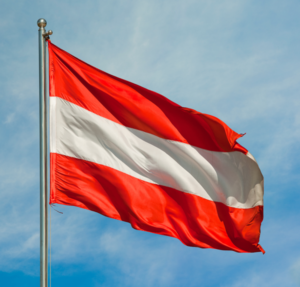
Top 10 historical sites for tourists in the Philippines.
1. Intramuros, Manila –
2. Banaue Rice Terraces –
3. Chocolate Hills, Bohol –
4. Taal Volcano and Taal Heritage Town –
5. Vigan, Ilocos Sur Philippines –
6. Corregidor Island, Cavite Philippines –
7. Tubbataha Reefs Natural Park, Palawan Philippines –
8. Mayon Volcano, Albay Philippines –
9. Paoay Church, Ilocos Norte Philippines –
10. Rizal Park, Manila Philippines –
1. Intramuros, Manila Philippines-
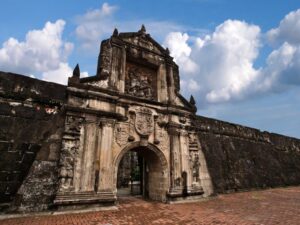
Intramuros, located in Manila, Philippines, is a historic walled area that offers a glimpse into the country’s colonial past.
Built during the Spanish colonial era, Intermoros in the Philippines is one of the major cultural and historical sites that attracts tourists around the world.
Visitors to Intramuros can explore its well-preserved architecture, including ancient churches, forts, and other structures that date back to the 16th century. One of the most iconic sites within Intramuros is Fort Santiago, a citadel that served as a defense fortress during the Spanish era.
Tourists can walk along the walls of the fort, visit the Rizal Shrine, and learn about the life and legacy of the national hero, Jose Rizal.
Another must-visit attraction in Intramuros is the San Agustin Church, a UNESCO World Heritage Site known for its Baroque architecture and ornate interiors.
The church houses a museum that showcases religious artifacts and artworks from the colonial period.
For a more immersive experience, tourists can take a guided walking tour of Intramuros, where knowledgeable guides provide insights into the history and significance of the various landmarks.
Visitors can also enjoy a leisurely stroll along the cobblestone streets, lined with charming cafes, souvenir shops, and art galleries.
Intramuros is not only a place of historical importance but also a vibrant cultural hub, hosting events, concerts, and festivals throughout the year.
Whether you’re a history enthusiast, architecture lover, or simply looking to immerse yourself in the rich heritage of the Philippines, a visit to Intramuros is a must-do experience for tourists in Manila.
2. Banaue Rice Terraces Philippines-
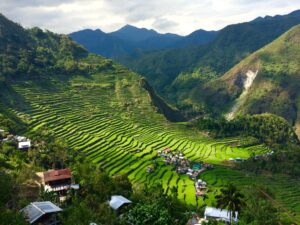
The Banaue Rice Terraces, located in the Philippines, is one of the breathtaking UNESCO World Heritage and historical Sites for tourists that showcases the ingenuity and cultural heritage of the Ifugao people.
Carved into the mountains of Ifugao over 2,000 years ago, these terraces are often referred to as the “Eighth Wonder of the World” due to their stunning beauty and historical significance.
For tourists visiting Manila, a trip to the Banaue Rice Terraces offers a unique opportunity to witness a living cultural landscape that has been passed down through generations.
The terraces are not only a marvel of ancient engineering but also a testament to the sustainable agricultural practices of the Ifugao people, who continue to cultivate rice on these terraces using traditional methods.
Visitors to the Banaue Rice Terraces can explore the various terraces, hike along ancient trails, and interact with the local community to learn more about their customs and way of life.
The terraces are also surrounded by lush forests, waterfalls, and traditional Ifugao villages, providing a truly immersive experience for travelers seeking to connect with nature and history.
While the journey from Manila to the Banaue Rice Terraces may be long and winding, the awe-inspiring views and cultural richness of this site make it a must-visit destination for those looking to delve into the heart of Filipino heritage. Whether you’re a history enthusiast, nature lover, or simply seeking a unique travel experience, the Banaue Rice Terraces offer a glimpse into a world where tradition and innovation coexist harmoniously.
3. Chocolate Hills, Bohol Philippines-
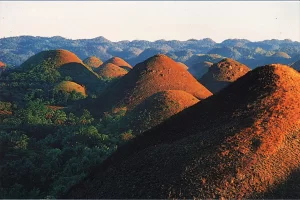
Chocolate Hills in Bohol, Manila, is a natural wonder that captivates tourists with its unique and breathtaking landscape.
These iconic hills, spread across an area of more than 50 square kilometers, are named for their resemblance to chocolate kisses during the dry season when the grass covering them turns brown.
The Chocolate Hills are a geological formation consisting of around 1,200 cone-shaped hills, creating a mesmerizing sight that is truly one-of-a-kind.
Visitors to Chocolate Hills can enjoy panoramic views of the rolling hills from viewing decks located in different parts of the area.
The best time to visit is during the dry season, from late November to May, when the hills take on their chocolatey hue. Exploring the hills on foot or by ATV offers a closer look at this natural marvel and allows for a more immersive experience.
Aside from the hills themselves, the surrounding area of Bohol offers a range of attractions for tourists to enjoy.
From the vibrant local culture to the diverse wildlife and pristine beaches, there is something for everyone in this picturesque province.
Tourists can also visit nearby attractions such as the Tarsier Conservation Area to see the adorable and endangered Philippine tarsiers up close.
Overall, a visit to Chocolate Hills in Bohol, Manila, promises a memorable and enchanting experience for tourists seeking to marvel at the wonders of nature and immerse themselves in the beauty of the Philippines.
4. Taal Volcano and Taal Heritage Town Philippines-
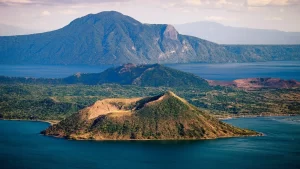
Taal Volcano, located in the Philippines, is a captivating destination for tourists seeking natural beauty and historical charm.
Initially, known as the world’s smallest active volcano, Taal Volcano is nestled within a picturesque lake, creating a stunning sight for visitors.
The volcano’s unique topography, with its crater lake and surrounding lush landscapes, offers a mesmerizing backdrop for outdoor enthusiasts and nature lovers.
Adjacent to Taal Volcano lies Taal Heritage Town, a quaint and charming town that exudes colonial-era charm.
Taal Volcano and Taal Heritage Town are among the historical sites and are home to well-preserved ancestral houses, churches, and structures that showcase the rich cultural heritage of the Philippines to tourists.
Walking through the cobblestone streets of Taal Heritage Town feels like stepping back in time, allowing visitors to immerse themselves in the country’s history and architectural beauty.
Tourists visiting Taal Volcano and Taal Heritage Town can embark on various activities to make the most of their experience.
Hiking to the crater of Taal Volcano offers a unique adventure and panoramic views of the surrounding landscapes.
Exploring Taal Heritage Town allows visitors to appreciate the intricate details of Spanish colonial architecture and learn about the town’s significant role in Philippine history.
Additionally, tourists can indulge in local cuisine, shop for traditional handicrafts, and interact with friendly locals to get a taste of authentic Filipino culture.
Whether seeking outdoor adventures, cultural exploration, or simply a peaceful retreat, Taal Volcano and Taal Heritage Town offer a diverse range of experiences for travelers looking to discover the beauty and history of the Philippines.
5. Vigan, Ilocos Sur Philippines Philippines-
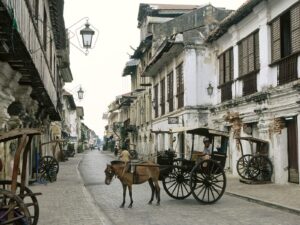
Vigan, located in Ilocos Sur, Philippines, is a charming city that offers a glimpse into the country’s colonial past.
Known for its well-preserved Spanish colonial and Asian architecture, Vigan has been recognized as a UNESCO World Heritage Site since 1999.
One of the main attractions in Vigan is Calle Crisologo, a cobblestone street lined with ancestral houses that date back to the Spanish colonial period.
Visitors can take a leisurely stroll along this picturesque street, admiring the unique architecture and soaking in the historical ambiance.
Vigan is also famous for its culinary delights, with local dishes such as empanada, longganisa, and bagnet being must-tries for food enthusiasts.
The city’s vibrant food scene offers a mix of traditional Filipino flavors and Spanish influences, making it a paradise for food lovers.
For history buffs, a visit to the Syquia Mansion and the Crisologo Museum provides insights into the lives of prominent Filipino families during the Spanish colonial era.
These museums showcase antique furniture, artifacts, and memorabilia that offer a glimpse into Vigan’s rich history.
Additionally, tourists can explore the Vigan Cathedral, also known as the St. Paul Metropolitan Cathedral, a prominent religious landmark in the city.
Its intricate architecture, historical significance, and sites make it a must-visit for tourists interested in the religious and cultural heritage of the Philippines.
Overall, Vigan is a destination that seamlessly blends history, culture, and gastronomy, offering a unique and enriching experience for tourists looking to immerse themselves in the rich tapestry of Filipino heritage.
6. Corregidor Island, Cavite Philippines –
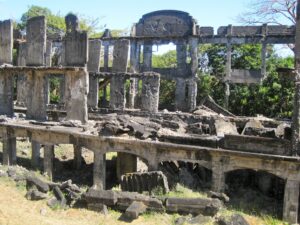
One of the historical sites and gems that draws tourists from all over the world is Corregidor Island, which is located in Cavite, Philippines.
This small tadpole-shaped island holds significant historical importance, particularly during World War II.
Visitors to Corregidor Island can explore the remnants of military fortifications, tunnels, and artillery that bear witness to the island’s role in defending the Philippines against Japanese forces.
One of the must-visit sites on Corregidor Island is the Malinta Tunnel, a network of tunnels that served as a bomb-proof storage and personnel bunker during the war.
Guided tours take visitors through the tunnel, providing insights into the island’s wartime history.
The Pacific War Memorial, located on the island, pays tribute to the soldiers who fought and died during the war, offering a poignant reminder of the sacrifices made.
Aside from its historical significance, Corregidor Island also boasts stunning views of Manila Bay and the surrounding waters.
Visitors can enjoy panoramic vistas from strategic vantage points on the island, offering a unique perspective of the area’s natural beauty.
For those interested in military history and World War II, Corregidor Island is a must-visit destination.
The island’s rich historical heritage, coupled with its scenic landscapes, makes it a compelling destination for tourists seeking a blend of education and natural beauty.
Whether exploring the tunnels, learning about the island’s past, or simply taking in the breathtaking views, a visit to Corregidor Island is sure to leave a lasting impression on any traveler.
7. Tubbataha Reefs Natural Park, Palawan Philippines –

Tubbataha Reefs Natural Park, located in Palawan, Philippines, is a marine sanctuary renowned for its pristine coral reefs and diverse marine life, making it a must-visit destination for tourists seeking a unique and unforgettable underwater experience.
Designated as a UNESCO World Heritage Site, Tubbataha Reefs Natural Park covers an area of approximately 97,030 hectares, encompassing two coral atolls and the surrounding waters.
The park is home to a stunning array of marine species, including over 600 fish species, 360 coral species, 11 shark species, and numerous seabirds, making it a paradise for snorkelers, divers, and nature enthusiasts.
The crystal-clear waters of Tubbataha Reefs offer excellent visibility, allowing visitors to witness the vibrant colors and intricate patterns of the coral reefs, as well as encounter a variety of marine creatures such as sea turtles, manta rays, and whale sharks.
For diving enthusiasts, Tubbataha Reefs Natural Park is a world-class diving destination, with its walls, drop-offs, and coral gardens teeming with marine life.
The park is known for its strong currents, which attract pelagic species and create thrilling drift dives for experienced divers.
Dive sites like Washing Machine and Shark Airport offer the chance to see schools of fish, reef sharks, and other exciting marine encounters.
To preserve the park’s delicate ecosystem, access to Tubbataha Reefs Natural Park is limited to a few months each year, typically from March to June, during the park’s peak season.
Visitors can explore the park through liveaboard diving trips, which provide an immersive experience in this underwater wonderland. Whether you’re a seasoned diver or a nature lover, Tubbataha Reefs Natural Park promises an unforgettable adventure in the heart of the Philippines’ marine biodiversity.
8. Mayon Volcano, Albay Philippines –
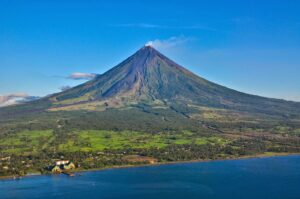
Mayon Volcano, located in Albay, Philippines, is a majestic natural wonder that captivates tourists from around the world.
Known for its near-perfect cone shape, Mayon Volcano is an iconic symbol of the Philippines and a must-visit destination for nature lovers and adventure seekers.
Standing at an impressive height of 2,462 meters, Mayon Volcano is an active stratovolcano that has erupted numerous times throughout history, shaping the landscape of the region and leaving behind a legacy of destruction and beauty.
Despite its volatile nature, Mayon’s allure lies in its breathtaking beauty and the surrounding lush greenery that contrasts with the volcano’s imposing presence.
Tourists visiting Mayon Volcano can embark on various activities to experience this natural wonder up close.
Hiking enthusiasts can challenge themselves by trekking to the volcano’s summit, where they can witness panoramic views of the surrounding landscape and the stunning Albay Gulf.
For those seeking a more leisurely experience, guided tours around the volcano offer insights into its geological history and cultural significance.
Additionally, the nearby Cagsawa Ruins provide a poignant reminder of Mayon’s power, with the remains of a church buried by a past eruption serving as a haunting yet captivating backdrop for visitors.
To fully appreciate the beauty and grandeur of Mayon Volcano, tourists can also indulge in local delicacies and immerse themselves in the vibrant culture of Albay, known for its warm hospitality and rich traditions.
In conclusion, a visit to Mayon Volcano in Albay, Philippines, promises an unforgettable experience filled with natural beauty, adventure, and cultural immersion, making it a must-see destination for travelers seeking to explore the wonders of the Philippines.
9. Paoay Church, Ilocos Norte Philippines –
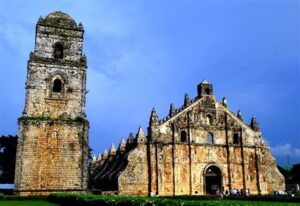
Paoay Church, also known as the San Agustin Church, is a UNESCO World Heritage Site located in Paoay, Ilocos Norte, Philippines.
This architectural marvel is a prime example of the Earthquake Baroque style, characterized by its massive buttresses on the sides and back of the building. Built in 1710, the church has withstood numerous natural disasters, showcasing the resilience and craftsmanship of its builders.
Tourists visiting Paoay Church are greeted by its imposing facade, adorned with intricate details and decorative elements.
The church’s bell tower stands separately from the main building, adding to its unique charm and historical significance.
Visitors can explore the interior of the church, featuring beautiful stained glass windows, ornate altars, and a serene atmosphere that invites contemplation and reflection.
Similarly, the Paoay Church holds a special place in Philippine history and culture, serving as a symbol of faith and endurance for generations of Filipinos.
Its architectural beauty historical sites and significance make it a must-visit destination for tourists seeking to immerse themselves in the rich heritage of the Philippines.
Surrounded by lush greenery and a peaceful ambiance, Paoay Church offers a tranquil escape from the hustle and bustle of modern life.
Visitors can take a leisurely stroll around the church grounds, admire the intricate details of the architecture, and learn about the fascinating history behind this iconic landmark.
Whether you’re a history enthusiast, architecture lover, or simply a curious traveler, Paoay Church in Ilocos Norte is a destination that promises a memorable and enriching experience for all who visit.
10. Rizal Park, Manila Philippines –
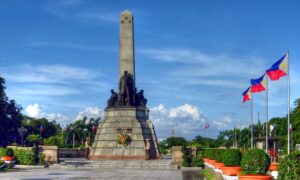
Rizal Park, also known as Luneta Park, is a historical urban park located in the heart of Manila, Philippines.
Named after the national hero, Dr. Jose Rizal, the park serves as a significant landmark that commemorates his life and contributions to the country’s independence movement. ”
Spanning over 140 acres, Rizal Park offers a serene escape from the bustling city life, providing locals and tourists alike with a peaceful oasis for relaxation and recreation.
Also, one of the park’s most prominent features is the Rizal Monument, a towering bronze sculpture that stands as a symbol of Filipino nationalism and patriotism.
Visitors can pay their respects to Dr. Jose Rizal by visiting this iconic monument, which is surrounded by lush greenery and manicured gardens.
Aside from its historical significance, Rizal Park also offers a variety of recreational activities for visitors to enjoy.
From leisurely strolls along the palm-lined pathways to picnics on the grassy lawns, the park provides a tranquil setting for outdoor gatherings and family outings.
Additionally, the park features open-air concert venues, playgrounds, and fountains, making it a popular destination for both locals and tourists seeking entertainment and relaxation.
For those interested in Philippine history and culture, Rizal Park also houses several museums and galleries that showcase artifacts and exhibits related to the country’s heritage.
Visitors can delve into the rich history of the Philippines through interactive displays and educational programs that highlight the nation’s past and present.
Overall, Rizal Park stands as a must-visit destination in Manila, offering a blend of history, nature, and recreation that appeals to visitors of all ages and interests.



